| From: http://www.bibleonly.org/exp/24q.html
In the last chapter of John’s gospel, we find the story of the 153 fish in the unbroken net. This is a gematria puzzle of considerable complexity. To illustrate the point of the story, we will reproduce its key elements.
a. Peter enters the boat, then six follow him (John 21:2-3)
The Greek gematria value of Simon Peter is 1925. If a circle of 1925 circumference is drawn to represent Peter, then it can be filled with six similar circles representing the others. Each circle touches the center and the perimeter. Then a circle is drawn around all seven circles. Its diameter is 1224, which is the gematria value of "fishes" and "the net".

b. Jesus tells the men to cast the net from the other side of the net. (John 21:6)
The net is drawn from the side of the first large circle which represents the boat. Another arc is drawn which now creates the "vesica piscis": the measure of the fish. A large rhomboid fish is drawn into the right piscis.
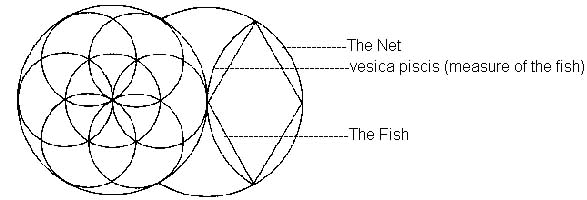
c. Peter is naked. He wraps his fisher’s coat around him, and jumps into the water from the other side of the boat. (John 21:7)
Another piscis is drawn on the other side, with Peter’s circle in it to represent Peter in the water. The height of the piscis is 1060, which is the gematria value of "fisher’s coat." A four by four net is drawn inside the large fish, and now we find the 153 fish. Each small "fish" has a width of 153, and there are a total of 17 fish: 16 small and one large. 153 is the sum of the numbers from 1 to 17.

d. For extended meanings, we now rotate the diagram so that the net is on the bottom and Peter is on the top.
We now have a diagram of the Gnostic cosmos as described by Plato in Timaeus. The net in the sea represents the shifting world of manifestation, where everything is in a state of flux and nothing forever remains the same. The upper world, the world of gods and first principles, is the Intelligible world: all of the universal laws on which manifestation is based. The middle world of Humanity partakes of both spirit and matter, the eternal and the temporal.
THE FISH IN THE NET
From: 'Jesus Christ - Son of God'
by David Fideler
The Symbolism of Apollo at Delphi
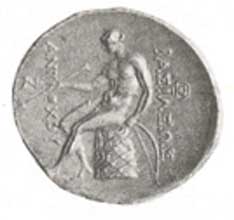
This diagram of the 153 fishes in the net is earlier than Christianity and is associated with the symbolism of Apollo at Delphi. Apollo is the earlier Greek personification of the Logos, the universal mediator, and it is ultimately from the mathematical symbolism of Apollo, the god of harmony, that both the diagrams of the 153 fish in the net and the feeding of the five thousand originate. Both of these diagrams are ultimately based on the numerical value of square root of 2 (1.415), the mathematical symbol of the ideal mean between unity and multiplicity, which is reflected in the title THE GOD APOLLO, 1415.
In the Christian version of John 21, the "foundation stone" of the geometry is the central circle of SIMON PETROS, 1925, the omphalos of Christianity, whose number determines the dimensions of the entire diagram. In this Christian adaptation, we start with "the omphalos" to arrive at the symbol of "the net". Likewise, in the earlier symbolism of Apollo, his omphalos at Delphi was covered with a net, symbolizing the veil of manifestation, woven from the central source of harmony. In the earlier version, the central circle symbolizes the omphalos at Delphi, the meeting point of heaven and earth, "the golden mean" of Apollo, The number 153 also figures in Delphic symbolism, for 1530 is the sum of DELPHI, 619, and OMPHALOS, 911.
Finally, if we draw a circle around the three worlds diagram, (above) the all-encompassing sphere has the measure of 7690, and 769, is the value of PYTHIOS, Apollo at Delphi.
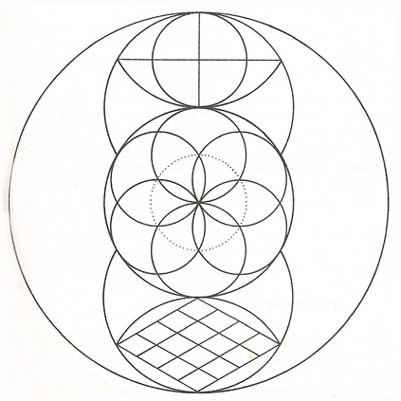
When Christianity began, the center represents Simon Petros as the omphalos, "the foundation stone" of Christianity.
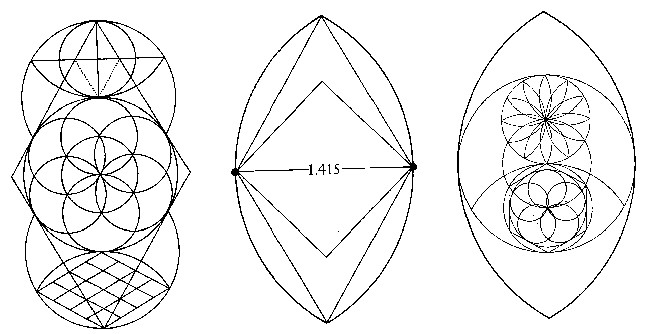
Figure 51: The Relationship between the 153 Fish in the Net and the Feeding of the Five Thousand.
This illustration shows how the mathematical progression illustrated in the previous diagram underlies the dimensions of the fish in the net geometry and the feeding of the five thousand. Both diagrams are thereby shown to be differing expressions of the same, underlying cosmological code.
The central figure is a vesica with a width of 1x the square root of 2 (1.415 = THE GOD APOLLO), which defines the diameter of the feeding of the five thousand geometry on the right.
The height of the central vesica measures 1 x the square root of 2 x the square root of 3 (2.448 = FISHES IN THE NET), which defines the height of the 153 fishes in the net geometry on the left.
In the diagram on the left, the rhombus intersects the length of the vesica in the upper world, dividing it into three equal segments of 353 units, the value of HERMES. This represents "Thrice-Great Hermes" or Hermes Trimegistos, a personification of the Logos.
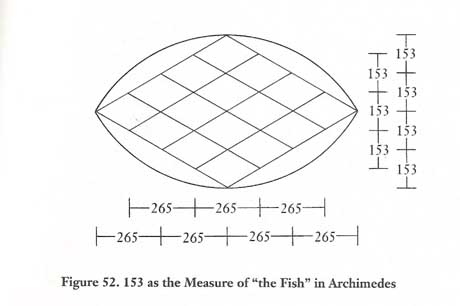
153 as the measure of "the Fish in Archimedes
Archimedes (c 287-212 B.C.E.), in his treatise On the Measurement of the Cycle, uses the whole number ratio 153:265 to accurately approximate the irrational ratio square root of 3, "the measure of the fish" or the vesica piscis. Moreover, Archimedes uses this value in such a manner as to suggest that this approximation was well know to his contemporaries: it required no word of explanation at all.
This ratio, 153:265, precisely relates to the dimensions of the 153 "fish" in the unbroken net, for it defines the height and width of each rhombus in "the net." Figure 52. Since 153 was known in the time of Archimedes as "the measure of the fish" or the vesica, ancient readers skilled mathematics would have immediately recognized the allegory of the 153 fish in the net for what is it: a geometrical "story problem."
|

